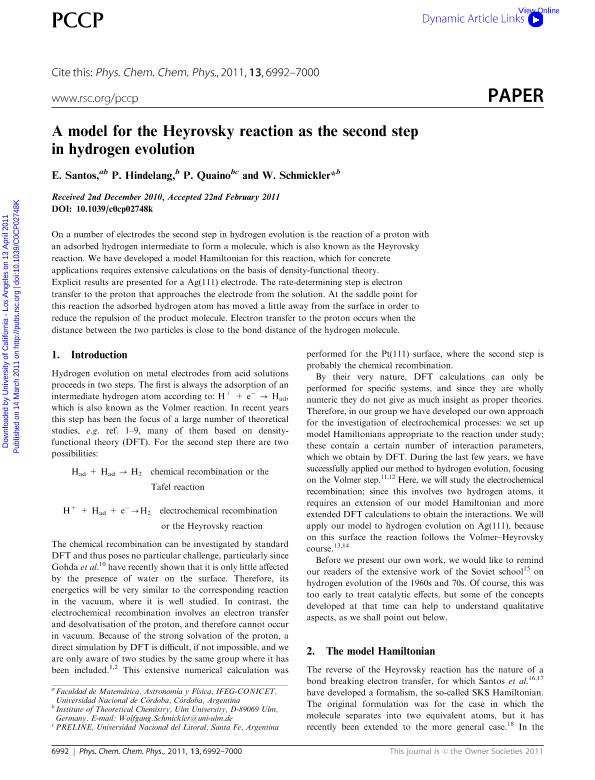Mostrar el registro sencillo del ítem
dc.contributor.author
Santos, Elizabeth del Carmen

dc.contributor.author
Hindelang, Peter
dc.contributor.author
Quaino, Paola Monica

dc.contributor.author
Schmickler, Wolfgang

dc.date.available
2019-04-11T22:12:02Z
dc.date.issued
2011-04
dc.identifier.citation
Santos, Elizabeth del Carmen; Hindelang, Peter; Quaino, Paola Monica; Schmickler, Wolfgang; A model for the Heyrovsky reaction as the second step in hydrogen evolution; Royal Society of Chemistry; Physical Chemistry Chemical Physics; 13; 15; 4-2011; 6992-7000
dc.identifier.issn
1463-9076
dc.identifier.uri
http://hdl.handle.net/11336/74183
dc.description.abstract
On a number of electrodes the second step in hydrogen evolution is the reaction of a proton with an adsorbed hydrogen intermediate to form a molecule, which is also known as the Heyrovsky reaction. We have developed a model Hamiltonian for this reaction, which for concrete applications requires extensive calculations on the basis of density-functional theory. Explicit results are presented for a Ag(111) electrode. The rate-determining step is electron transfer to the proton that approaches the electrode from the solution. At the saddle point for this reaction the adsorbed hydrogen atom has moved a little away from the surface in order to reduce the repulsion of the product molecule. Electron transfer to the proton occurs when the distance between the two particles is close to the bond distance of the hydrogen molecule.
dc.format
application/pdf
dc.language.iso
eng
dc.publisher
Royal Society of Chemistry

dc.rights
info:eu-repo/semantics/openAccess
dc.rights.uri
https://creativecommons.org/licenses/by-nc-sa/2.5/ar/
dc.subject
Heyrovsky Reaction
dc.subject
Hydrogen Evolution
dc.subject
Ag(111)
dc.subject.classification
Otras Ciencias Químicas

dc.subject.classification
Ciencias Químicas

dc.subject.classification
CIENCIAS NATURALES Y EXACTAS

dc.title
A model for the Heyrovsky reaction as the second step in hydrogen evolution
dc.type
info:eu-repo/semantics/article
dc.type
info:ar-repo/semantics/artículo
dc.type
info:eu-repo/semantics/publishedVersion
dc.date.updated
2019-04-05T14:33:25Z
dc.journal.volume
13
dc.journal.number
15
dc.journal.pagination
6992-7000
dc.journal.pais
Reino Unido

dc.journal.ciudad
Cambridge
dc.description.fil
Fil: Santos, Elizabeth del Carmen. Consejo Nacional de Investigaciones Científicas y Técnicas. Centro Científico Tecnológico Conicet - Córdoba. Instituto de Física Enrique Gaviola. Universidad Nacional de Córdoba. Instituto de Física Enrique Gaviola; Argentina
dc.description.fil
Fil: Hindelang, Peter. Institute of Theoretical Chemistry; Alemania
dc.description.fil
Fil: Quaino, Paola Monica. Institute of Theoretical Chemistry; Alemania. Universidad Nacional del Litoral. Facultad de Ingeniería Química. Programa de Electroquímica Aplicada e Ingeniería Electroquímica; Argentina. Consejo Nacional de Investigaciones Científicas y Técnicas. Centro Científico Tecnológico Conicet - Santa Fe; Argentina
dc.description.fil
Fil: Schmickler, Wolfgang. Institute of Theoretical Chemistry; Alemania
dc.journal.title
Physical Chemistry Chemical Physics

dc.relation.alternativeid
info:eu-repo/semantics/altIdentifier/doi/http://dx.doi.org/10.1039/c0cp02748k
dc.relation.alternativeid
info:eu-repo/semantics/altIdentifier/url/https://pubs.rsc.org/en/Content/ArticleLanding/2011/CP/c0cp02748k#!divAbstract
Archivos asociados
